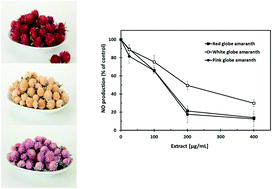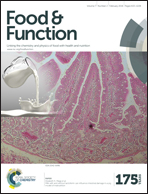A comparison of the bioactivity and phytochemical profile of three different cultivars of globe amaranth: red, white, and pink†
Abstract
The phytochemical profiles and bioactivities of red, white and pink globe amaranth (Gomphrena haageana K., Gomphrena globosa var. albiflora and Gomphrena sp., respectively), much less studied than the purple species (G. globosa L.), were compared. The chemical characterization of the samples included the analysis of macronutrients and individual profiles of sugars, organic acids, fatty acids, tocopherols, and phenolic compounds. Their bioactivity was evaluated by determining the antioxidant and anti-inflammatory activities; the absence of cytotoxicity was also determined. Red and pink samples showed the highest sugar content. Otherwise, the white sample gave the highest level of organic acids, and together with the pink one showed the highest tocopherol and PUFA levels. Quercetin-3-O-rutinoside was the major flavonol in white and pink samples, whereas a tetrahydroxy-methylenedioxyflavone was the major compound in the red variety, which revealed a different phenolic profile. The pink globe amaranth hydromethanolic extract revealed the highest antioxidant activity, followed by those of red and white samples. The anti-inflammatory activity was more relevant in red and pink varieties. None of the samples presented toxicity in liver cells. Overall, these samples can be used in bioactive formulations against inflammatory processes and in free radical production.



 Please wait while we load your content...
Please wait while we load your content...